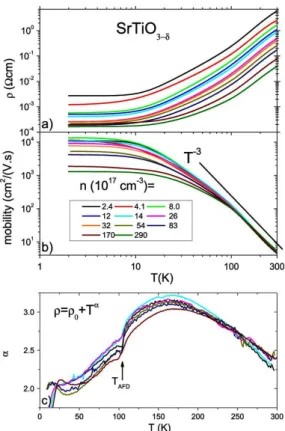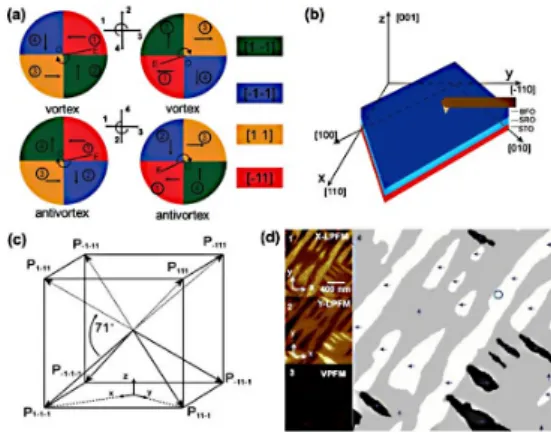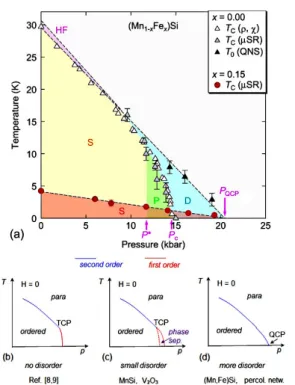量
量
量子
子
子材
材
材料
料
料大
大
大观
观
观园
园
园 (2)
刘俊明 渔家傲·风月文章 焉入十年风月里,低吟秋水万千思。 秀色文章难数已,重拾起,铅华不过平常记。 尚忆当时青涩事,一横一竖与君寄。 麾汗换来凌雪意,如今是,梅枝一夜红黄系。 FIG. 1 南大校园中的漫天吹雪让刚刚绽开的腊梅(图片上 方)隐入雪雾,却依然鲜艳!VI. 钛酸锶是个神奇的世界
SrTiO3 (STO) 是一种神奇的材料,她是绝佳的绝 缘体、氧化物单晶衬底、漂亮的装饰物。不过,她神奇 之处在于她的泰国人妖之面貌,经过简单化妆,她可 以是金属、超导体、量子顺电体、铁电体、热电材料、 光催化材料· · · 天知道还会有什么人能够再捣鼓出来 什么,比如说拓扑导电绝缘体! STO 的这些神奇中最不可思议的就是超导态和 金属态了。一个研究组,只要您胆子够大、力量够壮, 都可以试试这个人妖千面美女。好吧,法国国立物理 与材料实验室的一组学者专门研究 STO 金属态中电 阻与载流子(准粒子)密度的关系,突出了载流子在 STO 中是实实在在的,主要结果是这一关系超越著名 的 Mott-Ioffe-Regel 极限!好吧,超越· · · 事实上,在大学物理层次,经典的凝聚态物理框 架一向自祤以能带理论为核心划分世界: 金属、半导 体、绝缘体、磁学、铁电· · · 这些物理形态在电动力学 中都有所涉及。不过,我们很快就有了高温超导、庞磁 电阻等关联量子系统,其中你我不分、非此非彼的物 理形态比比皆是。如果要说有例外,极端情况下,还真 有那么几个体系能够藐视一切:硅 Si 算一个吧? ZnO 算一个吧? 这里的 STO 也算一个吧。她们通过简单的 调控即可以在所有属性中各态历经 (ergodicity)。从这 个意义上,现在我们胆大妄为地去看十九世纪二十世 纪的那些物理学“大师”们。他们受后辈恭维供奉了 一两百年,现在可以说:他们不过是看到那些简单的、 冰山一角的景观。 妄议到此,我们不需要妄自菲薄,且来看看这篇 文章吧: 原文链接:https://www.nature.com/articles/ s41535-017-0044-5Correlated matter: When metals go bad
An expected metallic behavior that defies existing theory is observed by researchers in France. Xiao Lin from the Laboratoire Physique et Etude de Matériaux and co-workers show that room temperature strontium titanate behaves like a so-called ‘bad’ metal. Particles with an electric charge can flow through a metal with little resistance. But this resistivity increases with par-ticle density. In conventional metals, this increase even-tually stops at what is known as the Mott-Ioffe-Regel limit. Bad or strange metals, however, defy this rule and the resistivity continues to increase. This effect is thought to arise when the when the electrons work col-lectively, creating quasi-particles. Lin and colleagues
show that this bad metal behavior can occur even in a material without quasi-particles. Instead, they argue the metallicity is caused by so-called Landauer trans-mission between individual dopants.
FIG. 2 (Resistivity and mobility in doped SrTiO3. (a) Tem-perature dependence of resistivity in SrTiO3-δ as the carri-er concentrations is tuned from 1017 to 1019cm−3. Room-temperature resistivity is several hundred times higher than low-temperature resistivity. (b) Hall mobility as a function of temperature. Above 100 K, the mobility does not depend on carrier concentration and is roughly cubic in tempera-ture. (c) Assuming that in elastic resistivity follows a pow-er law, i.e.,ρ = ρ0+ AT α, one can extract the exponent, α by taking a logarithmic derivative: α = d ln(ρ− ρ0)/d ln T , as in the case of cuprates. At low temperature, α ≈ 2. Above 50 K, it starts a significant shift upward and exceeds three around 150 K, before steadily decreasing afterwards. The antiferrodistortive transitionis the source of the small anomaly at 105 K
VII. 电荷密度波中的隐含序
量子凝聚态系统中神秘莫测的序很多,有些我们 认为已经搞得很清楚了但实际上没搞清楚,有些我们 认为没有搞清楚的现在知道是因为有隐含的有序相。 例如,在 URu2Si2 中,过去 30 多年的研究都看到这 是一个很典型的四方晶格,面内物理形态呈现四重对 称是顺理成章的。但是,这一体系有一些电子态又呈 现出典型的两重对称性,与凝聚态物理的对称性规律 不符。这一谜团直到最近才被弄清楚: 这一体系的电 子态实际上会沿着面内对角线方向发生小的形变,展 现出正交对称结构。我们将这一新形态称之为 hidden order,即隐含序。 当然,量子关联系统的研究最近揭示出很多所谓 的 hidden orders,就好像量子凝聚态系统不让宇宙学 独美,也不知道是不是受到暗物质或者暗能量概念的 激励,开始了一波又一波对量子隐含相的研究。要命 的是,暗物质和暗能量的概念主要基于明物质和明能 量的测量结果与大统一理论计算之间有很大出入而提 出,是不是属实还未有答案。而这里的隐含序却并非 如此,足够精细和灵敏的探测手段还是能够“看到”它 们在那里。 这里是一个极好的例子,看看韩国、英国、法国 和美国的喷子们是如何在 1T-TaS2 中找到隐含磁有序 的。当然,既然隐含,就要搞清楚其面貌;但是隐含自 然有隐含的道理,是不是有显性的应用,我们拭目以 待。 原文链接:https://www.nature.com/articles/ s41535-017-0048-1Charge-density waves: Alone no longer
Evidence for a hidden form of quantum correlation is uncovered by researchers in Korea, the UK, France and the USA. Marie Kratochvilova et al. from the In-stitute of Basic Science identify magnetic ordering in a material that is already well-studied for its charge-ordering properties. Charge-density waves occur when the electrons in a crystalline material create a standing-wave pattern. For example, an electron in each tanta-lum atom in tantatanta-lum disulfide (1T-TaS2) can strongly
interact with its neighbor to form a Star of David pat-tern: one electron on each of the twelve vertices, and one in the middle. Kratochvilova et al. now find evi-dence that these thirteenth ‘orphan’ electrons exhib-it their own type of ordering. The team measured the low-temperature magnetic properties of 1T-TaS2using
multiple techniques and identified short-range magnetic ordering in agreement with theoretical predictions.
FIG. 3 CDW structure and interplane stacking in 1T-TaS2. The lattice parameter a = 3.36 ˚A is depicted in the top view. In the case of the repetitive stacking with the nearest-neighbor distancesr r1 = 5.90 ˚A and r2= 8.29 ˚A only dou-ble layers one and two alternate while the screw stacking with the nearest-neighbor distancesr r1 and r
′
2 = 6.79 ˚A is formed by double layers one to four
VIII. 多铁性材料的老大也拓扑了
自然界有很多材料不但很神奇,而且是超级明星, 且能长盛不衰。这在我们的很多文献中都能看到类似 描述。例如,半导体中的 Si、超导中的 YBCO、介电 中的 STO、铁电中的 PZT、永磁中的钕铁硼、有机无 机杂化的钙钛矿等等。一方面,每一种材料都有某个 性能很难被超越。即便是某个单项被超越,也很难找 到综合性能亦非常优异的表现者。我们习以为常的是 太多文献都宣称某个材料的某个性能当属当前的吉尼 斯纪录,但依然是昙花一现居多。 事实上,这些明星材料因为长期被关注,其里外 材品都被研究得透彻,所以通过包装来展现全才功能 并不足为奇。当然,绝大多数情况下,一种明星材料 基本上就一个性能被广泛使用,更多的全才不是说不 存在,但要成为多面手材料其实很难。 不过,例外总是有的,这里展示其中一个例外就是 铁电材料中的 BiFeO3(BFO)。经过十五年包装,BFO 已经有铁电性、磁性、半导体阻变、光伏、金属导电性 等等,真的是万能材料,虽然还没有一种特性真的被 实际应用了。也许 Ramesh 是有点郁闷。 BFO 丰富的畴结构已经独领风骚十多年,主要由 71◦、109◦ 和 180◦ 这样三种畴和畴壁唱戏。不过,在 这里,南京大学的吕笑梅说 BFO 中畴结构有类拓扑的 vortex-antivortex 组态,且这一结构是可擦写的,稍 稍跌了不少人的眼球。因为实空间的拓扑畴用于信息 读写还是一个少人问津的方向,核心的科学问题可能 是这些拓扑畴如何被探测和利用。如果您有一台好的 PFM 仪器,到朱英豪那里要来一块薄膜样品,然后足 够细心和耐心,您就可以学习吕笑梅老师了。 原文链接:https://www.nature.com/articles/ s41535-017-0047-2Ferroelectrics:Electrically rewritable vortex pairs in bismuth ferrite
A demonstration of electrically-rewritable vortex pairs in a ferroelectric could provide a route to realizing vortex memory devices. Swirling vortex structures of electrical polarization that are relatively insensitive to external disturbances can form in ferroelectric material-s. As they can exist indifferent polarization states, vor-tices could be exploited for information storage appli-cations, but practical methods to manufacture and ma-nipulate them are required first. Using scanning probe microscopy-based methods, an international team of re-searchers led by Xiaomei Lu from Nanjing University demonstrate that ferroelectric vortex-antivortex pairs can be created and erased in bismuth ferrite films us-ing local electric fields. They also show that large-scale vortex networks can be created, which could bring the use of vortices inelectronic devices a step closer.
FIG. 4 Ferroelectric domains in BiFeO3films. (a) Schemat-ic of vortex and antivortex structures.(b) SchematSchemat-ic of PFM detection of (001) BFO/SRO/STO. (c) Possible directions of the polarization vector P (solidlines) and switching paths in a (001)-oriented BFO thin film. (d) x-Lateral Piezoelec-tric Force Microscope (x-LPFM) (d1), y-LPFM (d2), Ver-tical Piezoelectric Force Microscope (VPFM) (d3) images, and 3D domain pattern (d4) of the same region. x and y indicate slow scan axis and fast scan axis, respectively. The dark blue ring represents the poling position. White, light gray, dark gray, and black regions represent for domains with in-plane polarization along [1-1], [-1-1], [11], and [-11] direction, respectively
IX. 量子临界性处的风景
量子临界现象类比于经典相变中的临界现象,是 collective 物理的重要方面,在我们目前所关注的几乎 所有量子物理行为中都能找到踪影。那么到底什么是 量子相变? 针对某个材料对象,如果相图中展示出一 个连续相变的临界温度随某个物理调控参数连续下降 到绝对零度,这个相图点一般称之为量子相变。事实 上,一个连续相变如果能发生,她总是会在某个有限 温度,而海森堡测不准原理蕴含的量子涨落会导致这 一相变点走向绝对零度。 最著名的就是高温超导了,相图中反铁磁与超导 竞争的那幅架势“全球”闻名,人人皆知。经典临近相 变行为因为平均场理论、普适标度理论和重整化理论 的辉煌,使得量子物理研究者垂涎三尺。也因为如此, 这个世界上有那么些个研究组不遗余力持之以恒地对 量子临界现象给予关注,试图得出其中与经典临界行 为类似的漂亮规律。目前,尚不是很清楚量子临界性 有哪些潜在的出口可以吐纳新的应用价值。 当然,这个方向还只是开始,应该说还在积累数 据的初级或者中级阶段,这里展示了美国人、瑞士人 和德国人一起捣鼓的一个独特而新颖的实例。 原文链接:https://www.nature.com/articles/ s41535-017-0049-0Quantum criticality: Iron aids restoration
An exotic quantum state of matter is identified in a new material by researchers in the USA, Switzerland and Germany. Yasutomo Uemura from Columbia U-niversity and co-workers observe quantum criticality in a material in which it was previously unseen just by adding iron. As pressure is increasingly applied topure manganese silicon at absolute zero temperature, it can suddenly change from an ordered magnetic state to an unordered one. Uemura et al. now show that a slow-er continuous, or second-ordslow-er, transition is obsslow-erved instead when fifteen percent of the manganese atoms are replaced with iron atoms. This is indicative that a quantum critical point exists at a pressure of between 21 and 23 kilobar. They believe that criticality is re-stored because the iron atoms introduce disorder into the system.
FIG. 5 Temperature–pressure phase diagrams of MnSi and (Mn,Fe)Si. (a) Temperature versus hydrostatic pressure phase diagram in pure MnSi and (Mn,Fe)Si in zero mag-netic field. Open triangles represent the magnetic tran-sition temperature determined by resistivity and suscepti-bility, gray-colored triangles from MuSR, and closed trian-gles represent the onset temperature of diffuse scattering “partial order” in quasi-elastic neutron scattering (QNS). The yellow-colored region (S) represents the helically or-dered phase, the green colored region (P) indicates phase separation between ordered and paramagnetic phases, and the blue colored region (D) indicates slow, dynamic, diffu-sive helical spin fluctuations. The small pink region (HF) above TC hashelical spin fluctuations leading to a weakly first-order thermal transition.Red circles indicate the tran-sition temperature for (Mn0.85Fe0.15)Si, determined by the present MuSR measurements. (b)–(d) Expected phase di-agrams of itinerant-electron magnets according to theories by Belitz, Kirkpatrick and co-workers with the effect of dis-order. TCP denotes the tri-critical point and QCP denotes the quantum critical point. The blue line indicates a second-order phase transition, while the red line shows a first-second-order phase transition. The first-order line in (b) intersects thep-axis vertically at T = 0. The MuSR results for pure MnSi can be viewed as a manifestation of case (c), and the present results for (Mn,Fe)Si as case (d). The recent MuSR results on V2O3may correspond toc, while the second-order phase transition in a highly random percolation network may bere-lated to (d)
X. 负磁阻是威尔费米子的尾巴
金属间化合物是个宝,这个我知道。以前一说金 属间化合物,我只知道是一些高温合金材料,高温力
学和机械服役性能好。其实,金属间化合物是以离子 键和共价键为主的氧化物、硫化物和各种卤素化合物 并驾齐驱的大材料体系,其中蕴含的未被发现的新功 能和新物理“罄竹难书”。
这 里, 我 们 的 铁 基 超 导 化 合 物 发 现 者 Hideo Hosono (细野秀雄)与 Yaoqing Zhang 博士一起,报 道了电子盐化合物 Nb5Ir3 具有超导电性,让我们吓了 一跳! 这里,所谓电子盐,就是说化合物的“阴离子” 是电子,而不是传统意义上的带负电的离子。这些阴 离子电子被局域化在金属间化合物的晶格间隙处!这 个图像应该是很不量子力学的,我还处在懵懵懂懂的, 感觉也很是莫名其妙。很显然,离子外层的电子被当 作载流子输运,这是常态,可以看作是离子“参与”导 电。但是,将电子这个量子“粒子”或者“波”作为阴 离子参与晶体结构的构建,这应该还是新鲜事,出来 很多槽点并不奇怪,难的是谁能想到这个“量子”能 够作为一个“离子”呢? 稍微熟悉一点凝聚态和材料物理的人都会问: 一 个“量子”镶嵌在晶格中,怎么个局域化? 安德森先生 处理过吗? 唉! 原文链接:https://www.nature.com/articles/ s41535-017-0053-4
Intermetallics:Superconductivity coexists with electride behavior
Coexistence of electride behavior and supercon-ductivity is observed in a hexagonal phase of a Nb5Ir3
intermetallic with tunable electronic properties by in-troducing foreign atoms. A team led by Yaoqing Zhang and Hideo Hosono from Japan Science and Technolo-gy Agency and Tokyo Institute of TechnoloTechnolo-gy report a new hexagonal phase in the phase diagram of Nb–Ir binary intermetallics with interesting interplay of su-perconductivity and electride state. The electride s-tate is formed by electrons detaching from the atoms but localizing in a one-dimensional channel space. This electride becomes a superconductor below a transition temperature of about 9.4 K, which could be enhanced to 10.5 K upon filling interstitial cavities with foreign oxygens. The results suggest a general rule governing the formation of electrides and form the basis for novel stable functional electrides.
FIG. 6 Electronic structures of different materials. Cal-culated band structures and density of states (DOS) for (a) [Nb5Ir3]2+: 2e− with corresponding electron densi-ty for the channel bands (ChBs) and electron localiza-tion funclocaliza-tion (ELF) map on the (1-100) plane parallel to the c-axis in (c)and (d), respectively, and f Nb5Ir3O. (b, e) Band structures of one-dimensional (1D) electrides (b) [La8Sr2(SiO4)6]4+:4e− and (e) Y5Si3. The characteristic ChBs are circled in red for all electrides
注:文中英文简介由 Nature Publishing Group 编辑队 伍专门为 npj Quantum Materials 刊物论文所撰写,于 每篇文章的链接里可以看到。



![FIG. 6 Electronic structures of different materials. Cal- Cal-culated band structures and density of states (DOS) for (a) [Nb 5 Ir 3 ] 2+ : 2e − with corresponding electron densi-ty for the channel bands (ChBs) and electron localiza-tion funclocaliza-tion](https://thumb-ap.123doks.com/thumbv2/9libinfo/6994046.456/5.892.484.797.114.480/electronic-structures-different-materials-structures-corresponding-electron-funclocaliza.webp)